Printed Books vs eBooks Statistics, Trends and Facts [2024]
Posted by Rob Errera on 05/31/2023
![Printed Books vs eBooks Statistics, Trends and Facts [2023]](https://cdn11.bigcommerce.com/s-dnybxc6/images/stencil/750x500/uploaded_images/paper-books-vs-ebooks-statistics.jpg?t=1617429184)
At a Glance: Books vs. eBooks
- The global paper books market will encompass around 1.87 billion readers by 2027, while e-reader users are expected to reach 1.2 billion.
- The U.S. market demonstrates a continued preference for print books with 788.7 million units sold in 2022.
- Despite trends towards digitalization, a 2021 survey revealed that 68% of younger readers (18 to 29-year-olds) in the U.S. prefer print books.
- At the same time, eBook sales in the U.S. are gradually increasing, with a 3.7% growth in January 2023 vs. January 2022, resulting in $85 million in revenue.
- Amazon's Kindle currently dominates the e-reader market, holding a substantial 72% share.
- Between 2021 and 2023, the average price gap between eBooks and hardcovers on Amazon increased by 75% in favor of eBooks.
Paper books vs eBooks statistics show print is here to stay!
Dead Tree Editions Just Won’t Die!
Like the monster in a horror movie, print books just won’t die. The most recent paper books vs eBooks statistics, research, and surveys back this up.
Print books are here to stay!
Let’s look at the most important eBook vs print book statistics, key differences between print and e-books, and where American publishers are taking the industry.
Popularity Contest: eBooks Versus Print Books
Are print books still popular? You’d better believe it!
According to the most recent survey conducted by the Pew Research Center on book consumption and book formats, traditional print is still the most popular reading format for both adults and children.
Survey says:
- 75% of adults in the United States read a book in some format over the last year
- 32% of Americans claim they only read print books
- 33% say they read both print books and e-books
- 9% say they only read e-books
- 23% of the respondents said that they don't read books
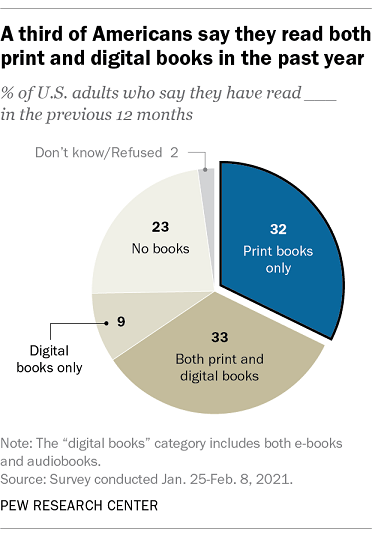
eBooks vs Printed Books Sales
- Print books out-sell eBooks 4 to 1
- 191 million e-books were sold in the United States in 2020
- In January 2023, eBook sales in the US experienced a 3.7% increase vs. January 2022, resulting in $85 million of generated revenue.
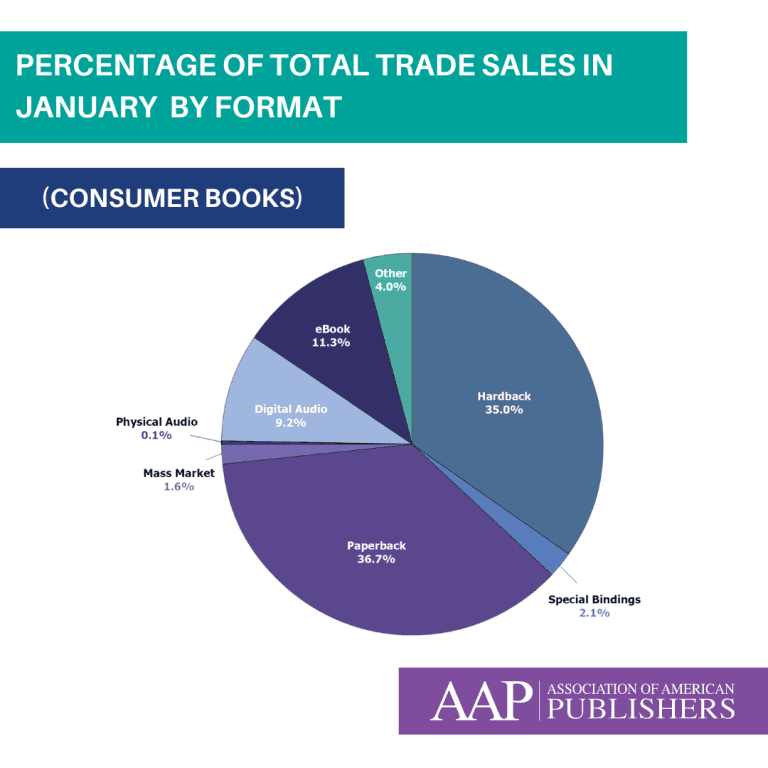
- Printed book sales amounted to 788.7 million units in 2022. Although there was a decrease compared to the previous year, the figure remains higher than in the years preceding 2021.
- Print book sales have increased 13.2% between 2020 and 2021, and 21% between 2019 and 2021
- eBook sales grew by 22% in 2020
- eBook sales have decreased 8% in 2021 but were still 8% higher than they were in 2019
Print book sales in the US from 2004 to 2022
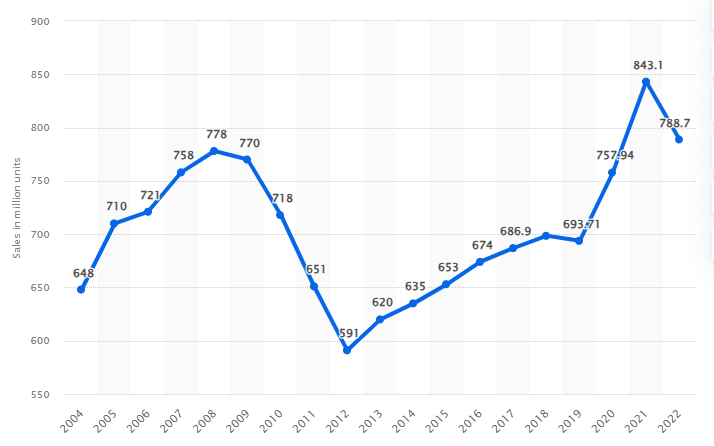
Source: Statista
eBook book sales in the US from 2010 to 2020
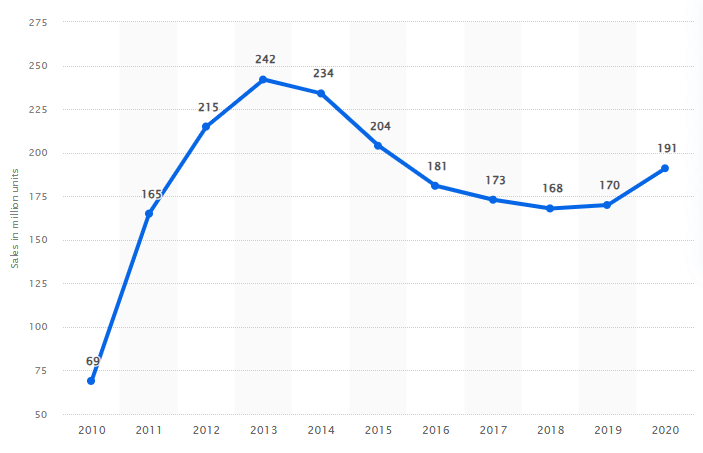
Source: Statista
Kindle vs Book Statistics
By far, the most popular e-reader on the market is Amazon’s Kindle.
The Kindle comes in a variety of formats — color, glare-free, etc. — but all use the AZW eBook format. Most other e-readers, like the Barnes & Noble Nook and Apple Books, use the more ubiquitous EPUB format for eBooks.
- 72% of the e-reader market belongs to Amazon Kindle
- 10% of the e-reader market belongs to Barnes & Noble Nook
- 18% of e-readers use an alternative app for digital reading
A more recent study from Pew Research suggests more people are reading on their smartphones and tablets, leading to a recent decrease in e-reader sales.
A 2012 report from NewZoo found 17.4 million active Kindle Fire users and 30.5 million iPad users in the United States. By 2018 Amazon reported selling close to 90 million e-readers. By 2027, Statista projects the number of e-reader users to grow to 1.2 billion, resulting in an expected revenue of $15.39 billion in the eBooks market.
Check also ➜ How Many Books Are Published Each Year?
Demographics: Reader vs E-Reader
Book reading demographics vary according to education and income level.
College graduates make up 90% of book readers, while only 61% of high school graduates read books.
Those who dropped out of school have an even lower readership rate - a mere 32%.
Economics goes hand-in-hand with education. Individuals earning over $75,000 a year make up 86% of readers, while well those earning less than $30,000 annually make up only 62%.
Physical books are still the top moneymakers for publishers.
Publishing market research shows the economic juggernaut of traditional books. While publishers are experimenting with different media formats — especially audiobooks — they are still investing the bulk of their marketing efforts into physical book sales.
And they should...there’s still big money in old-fashioned publishing!
- The Physical Books market is projected to reach 1.87 billion users by 2027, with an average revenue per user (ARPU) of $37.41.
- In 2021, the US book publishing industry achieved its highest-ever revenue of $29.33 billion, as reported by StatShot Annual. This marked a remarkable 12.3% increase, amounting to $3.23 billion, compared to the revenue of $26.1 billion in 2020
.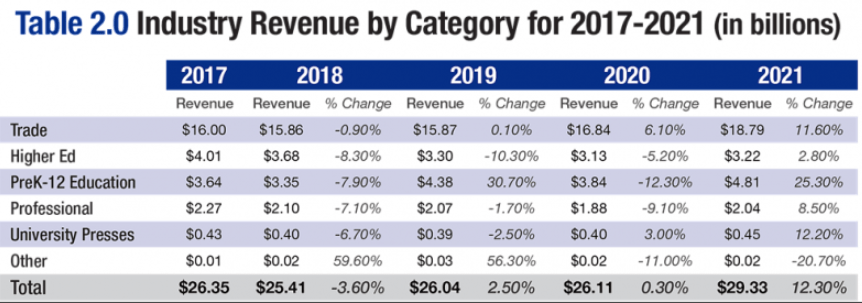
The United States Book Publishing Industry Revenue by Category
- Physical formats accounted for over 75.5% of the revenue for trade (consumer books) publishers.
- E-books experienced a 5.0% decline compared to 2020, totaling $1.97 billion and making up 10.5% of publishers' overall revenue for the year.
- In 2020, 19% of adult readers owned an e-reader, a decrease from 32% of adult readers who owned e-readers in 2014.
Canada Book Market Mirrors The US
Canadian booksellers see the same trends as the United States: people prefer print when it comes to long-form reading.
A 2022 survey from Canadian Book Consumer Study supports these findings:
- Print books accounted for 73% of purchases made by Canadian buyers
- E-books represented 17% of the purchases
- Audiobooks accounted for 6% of the total
The Distribution of Book Purchases by Format in Canada (From 2019 to 2022)
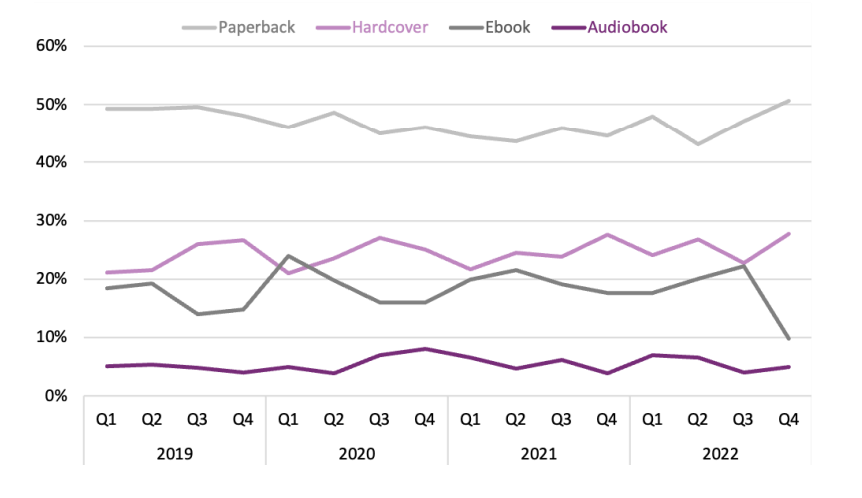
- Among book buyers, those aged 35 to 44 accounted for the highest percentage of print book purchases, with 25%
- In 2022, print books comprised 71% of library borrowings, while eBooks accounted for 21% and audiobooks made up 8%.
And this trend is not just confined to North America. The same thing happens in a dozen different countries.
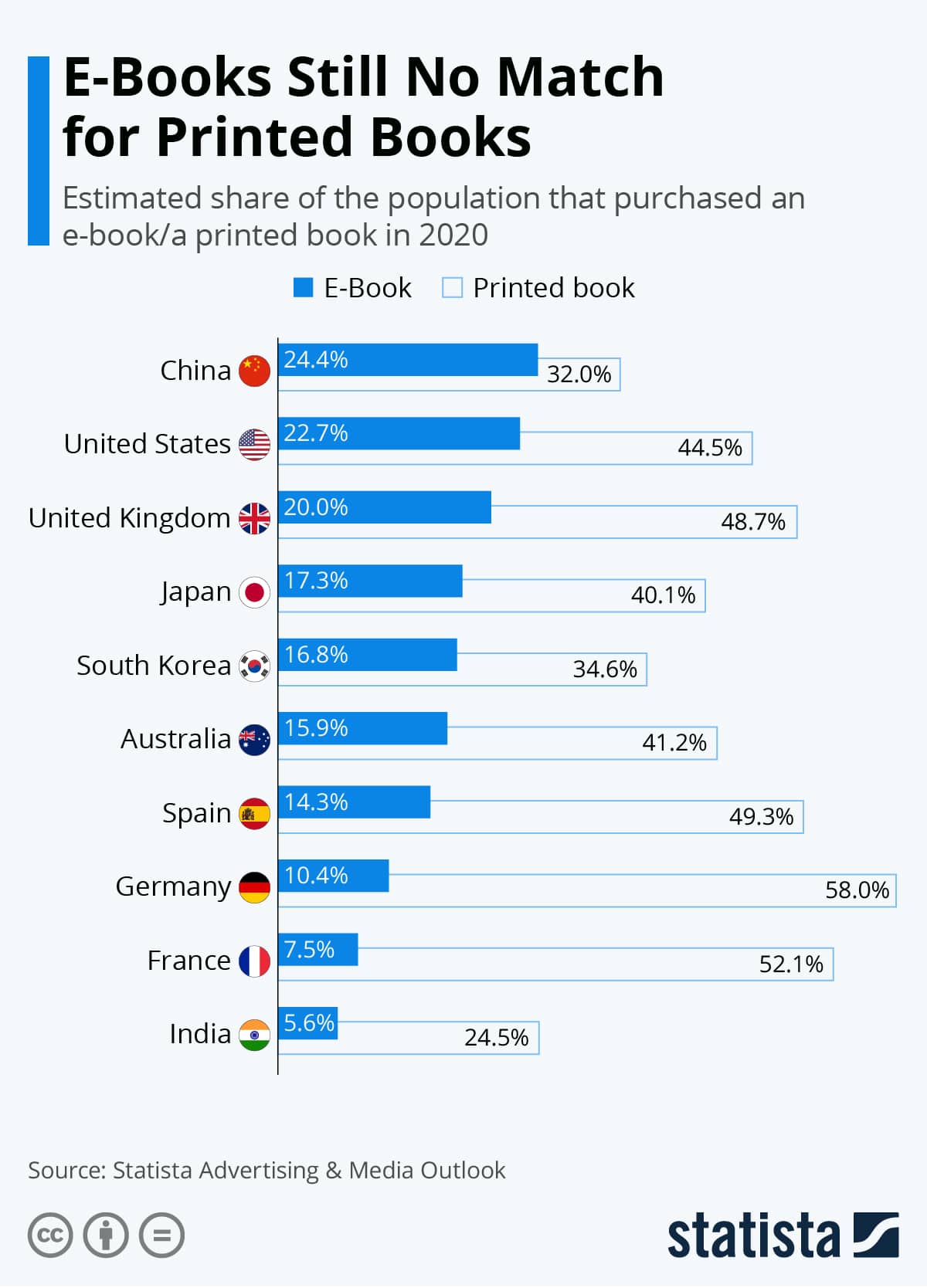
Reader vs. E-Reader Statistics: Educational Levels
College graduates:
- 88% read a book last year
- 80% read a print book
- 39% read an e-book
- 32% listened to an audiobook
High school (or less) graduates:
- 59% read a book last year
- 51% read a print book
- 17% read an e-book
- 13% listened to an audiobook
Reading Habits Reported by Various Groups in the US
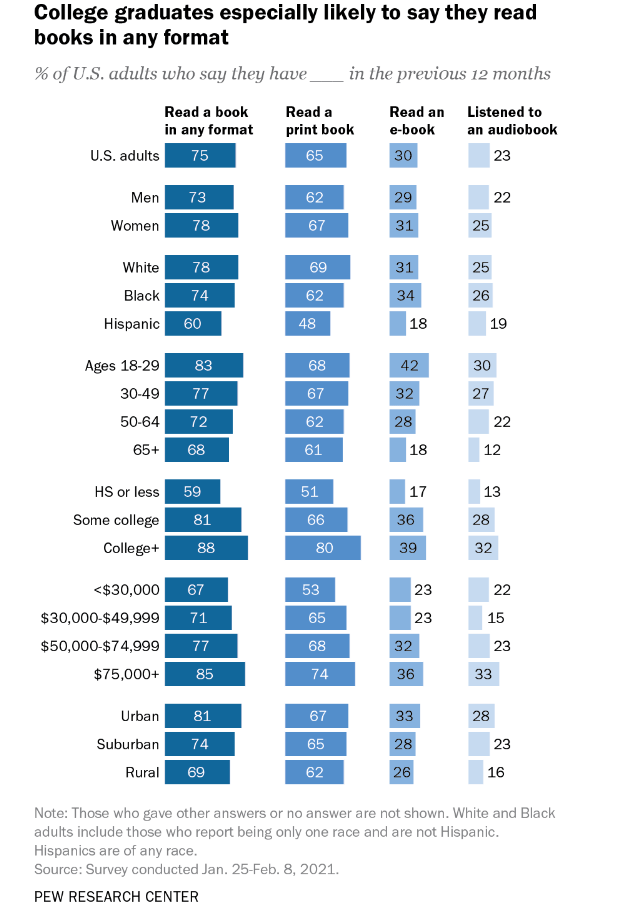
Reader vs. E-Reader Statistics: Income Levels
- 86% of people earning over $75,000 per year read a book last year.
- 78% of people earning between $50,000 and $75,000 per year read a book last year.
- 67% of people earning between $30,000 and $49,000 per year read a book last year.
- 62% of people earning below $30,000 per year read a book last year.
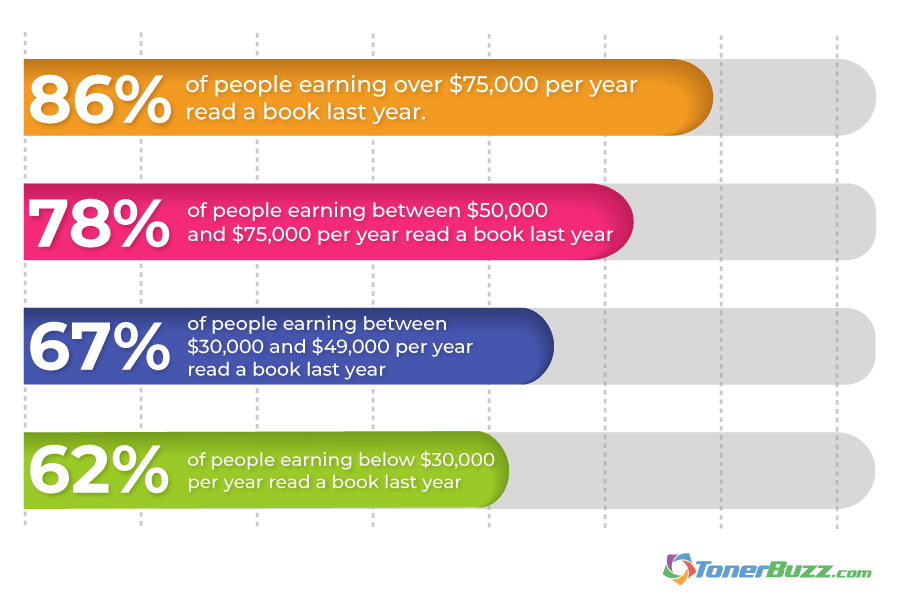
Print Book Youth Movement
One of the main reasons physical books are here to stay is because the next generation of readers has already embraced them.
Studies by Pew Research Center show that the most avaricious readers are young adults, with 83% responding they read a book in some format in 2021.
Data gathered from surveys and studies helps shape market trends.
In 2021:
- 83% of people aged 18-29 read a book
- 77% of people aged 30-49 read a book
- 72% of people aged 50-64 read a book
- 68% of people aged 65 and older read a book
- 62% of 16 to 24-year-olds preferred print books to e-books
- 68% of 18 to 29-year-olds preferred physical books to e-books
- Only 4% of children’s fiction was published in digital formats in 2021
eBooks vs Print Books: Costs & Savings
In the early days of eBook publishing, the digital versions of books were priced much cheaper than the print versions.
This made sense.
There were no printing, paper, or shipping costs involved, so a digital book should naturally cost less. A decade ago, it was not uncommon to see a hardcover bestseller priced at $25 with a digital edition price around half that.
Today the prices of physical books are much closer, especially when it comes to new releases and popular authors.
The cost of the latest Susanne Collins or Stephen King book will be nearly the same in both hardcover and e-book editions.
The real savings of eBooks come with older works and backlist titles. The digital editions of books that have been available for a while drop significantly. You can get eBook editions of classic literature for very cheap (even free).
Independent authors also offer up a wide variety of eBooks that are priced less than books from traditional publishers.
There are bargain books in both the physical and digital realms. You can find plenty of one-dollar eBooks online, enough to max out your e-reader. You can also find a table filled with $5 hardcovers at the local warehouse store.
Overall, eBooks will save avid readers money, but not as much you’d expect.
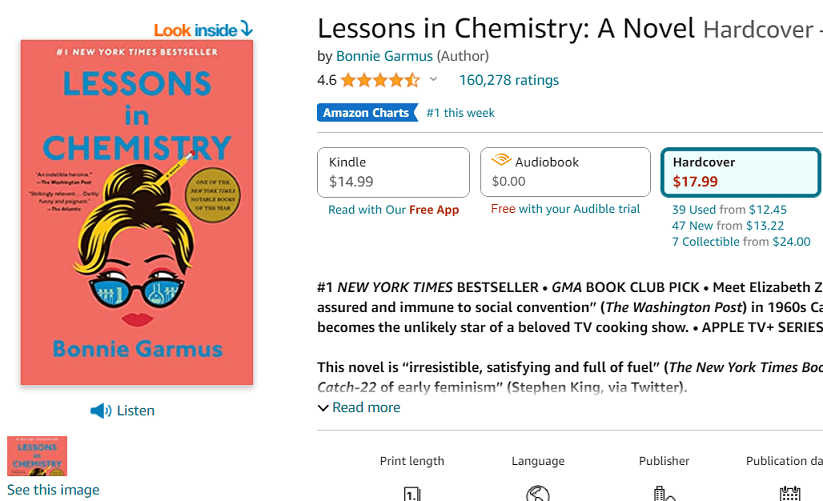
Hardcover vs. Kindle on Amazon: Kindle version costs 17% ($3) less than Hardcover
eBook vs Print Book Costs in 2023
Amazon Bestseller list 01/10/23:
- Prince Harry The Duke of Sussex's “Spare” is $19.99 hardcover and $17.99 eBook - 2.00$ difference in favor of the eBook
- James Clear’s “Atomic Habits” is $14.89 hardcover and 12.99 eBook - $1.90 difference
- Collen Hoover’s “It Ends with Us” is $20.24 hardcover and $12.99 eBook - $7.25 difference
- Collen Hoover’s “It Starts with Us” is $36.23 hardcover and $13.99 eBook - $22.24 difference
- Bonnie Garmus “Lessons in Chemistry” is $17.99 hardcover and $14.99 eBook - $3.00 difference
- Dav Pilkey’s “Dog Man: Twenty Thousand Fleas Under the Sea” is $9.49 hardcover and $9.99 eBook - $0.50 difference
As we can see, new hardcover bestsellers sell for an average price of $19.80 in 2023 while their eBook counterparts sell for around $12.
So, if you like to read hot-of-the-press bestsellers, choosing eBooks over physical books will save you about $7 per title … and a whole lot of shelf space!
eBook vs Print Book Costs in 2021
To compare let's look at the same data from 2021.
The difference in price between eBooks and paper books was less back in 2021 with some Kindle versions selling at a higher price than hardcover:
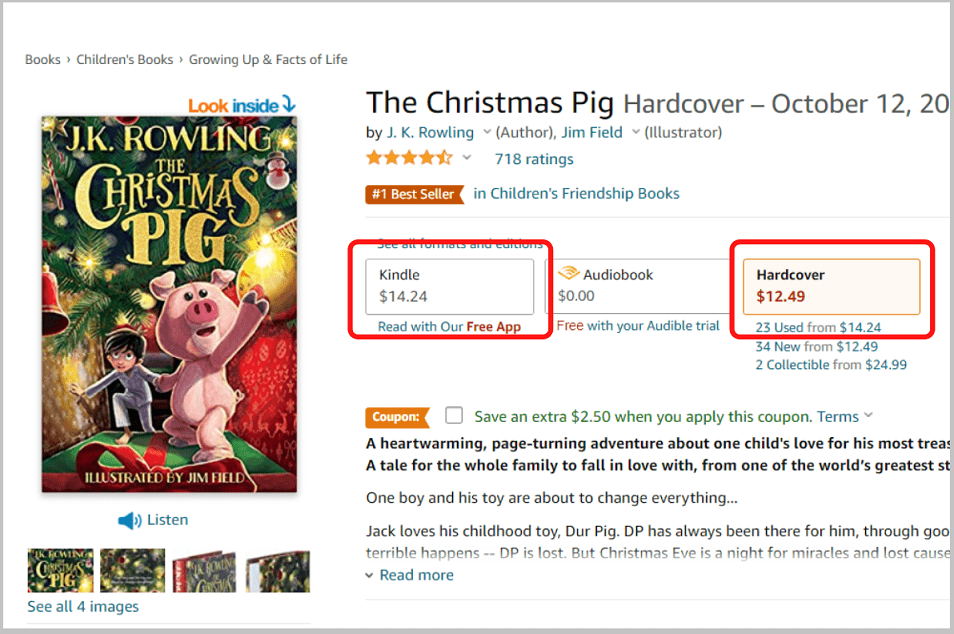
eBook offered at a higher price than Hardcover on Amazon
Amazon Bestseller list 10/12/21:
- JK Rowlings’s “The Christmas Pig” is $12.49 hardcover and $14.24 eBook - 1.75$ difference in favor of the the Hardcover
- Adam Schiff’s “Midnight in Washington” is $25.49 hardcover and 14.99 eBook - $10.50 difference
- Dave Grohl’s “The Storyteller” is $19.49 hardcover and $14.99 eBook - $4.50 difference
- Ron and Clint Howard’s “The Boys” is $20.49 hardcover and $14.99 eBook - $5.50 difference
- Nicholas Sparks “The Wish” is $15.99 hardcover and $14.99 eBook - $1.00 difference
- Anthony Doerr’s “Cloud Cuckoo Land” is $18.57 hardcover and $14.99 eBook - $3.58 difference
Based on the numbers above, new hardcover bestsellers sold for an average price of $19.30 in 2021 while their eBook counterparts sold for around $15. This means that eBooks were saving you about $4 per title in 2021 compared to $7 in 2023.
So, from 2021 to 2023 the difference in price between eBooks and hardcovers increased by 75% (or $3) in favor of eBooks.
Currently, there are still some ongoing supply chain delays that might be influencing the book market. Until everything stabilizes, we probably could see further, and at times drastic, fluctuations in the pricing of physical books versus eBooks.
Don’t Forget Your Local Library
You can’t get cheaper than free. Public libraries across the country allow you to borrow print and digital editions of books for a select period of time, usually a week or two.
As long as you return your borrowed books on time and in good condition, the local library offers a lifetime of free reading
Plus, libraries are one of the biggest buyers of books. Let them make the investment while you reap the reading rewards!
The Benefits of E-Books
A book isn’t paper and binding. It is the words and ideas contained between the covers.
An e-book contains all of the words and information of a print edition with a number of additional benefits:
- The key difference between e-books and printed books is this lack of a physical object.
- For starters, one difference is that an e-book is more portable than a print book.
- You can store an entire library of e-books on your phone or tablet and not take up an inch of physical shelf space. Kindle libraries can be vast and contain appropriate content for people of any age.
- E-books take up very little data. Even if your data is limited, a dozen full-length editions will occupy no more than a megabyte of disk space. It’s hard for print to compete in this area of books vs. e-books. Physical books take up a lot of physical space.
- E-books do not have a fixed font size. Make those letters big and easy to read before bed. Or change the color of the type or the background. The options are endless and the convenience outstanding.
- Adopting e-book technology can make you more well-read. Your Kindle will survey your e-book reading tastes and report suggestions based on titles with a related association.
- In addition, e-books have the benefit of a built-in dictionary. No more guessing at word meanings based on their context. You could look up word definitions on the fly. Even search the web to get deeper details about the eBook you’re reading.
- E-books also offer an excellent way to take notes regarding the text you were reading. Digital notes can be exported into any text editor and you’re halfway through your book report or online review!
- Like all digital files, eBooks are also very convenient for sharing. Reader-community apps, like Goodreads, allow you to share your reading progress with others almost like a built-in book club you can join or occasionally check in on.
- E-books are also easier on the environment. Gone is the association with stinky paper mills and unnecessary tree slaughter. No glue, no expensive ink. Unlike paper books, eBooks leave little to no carbon footprint.
Latest eBook Sales Numbers
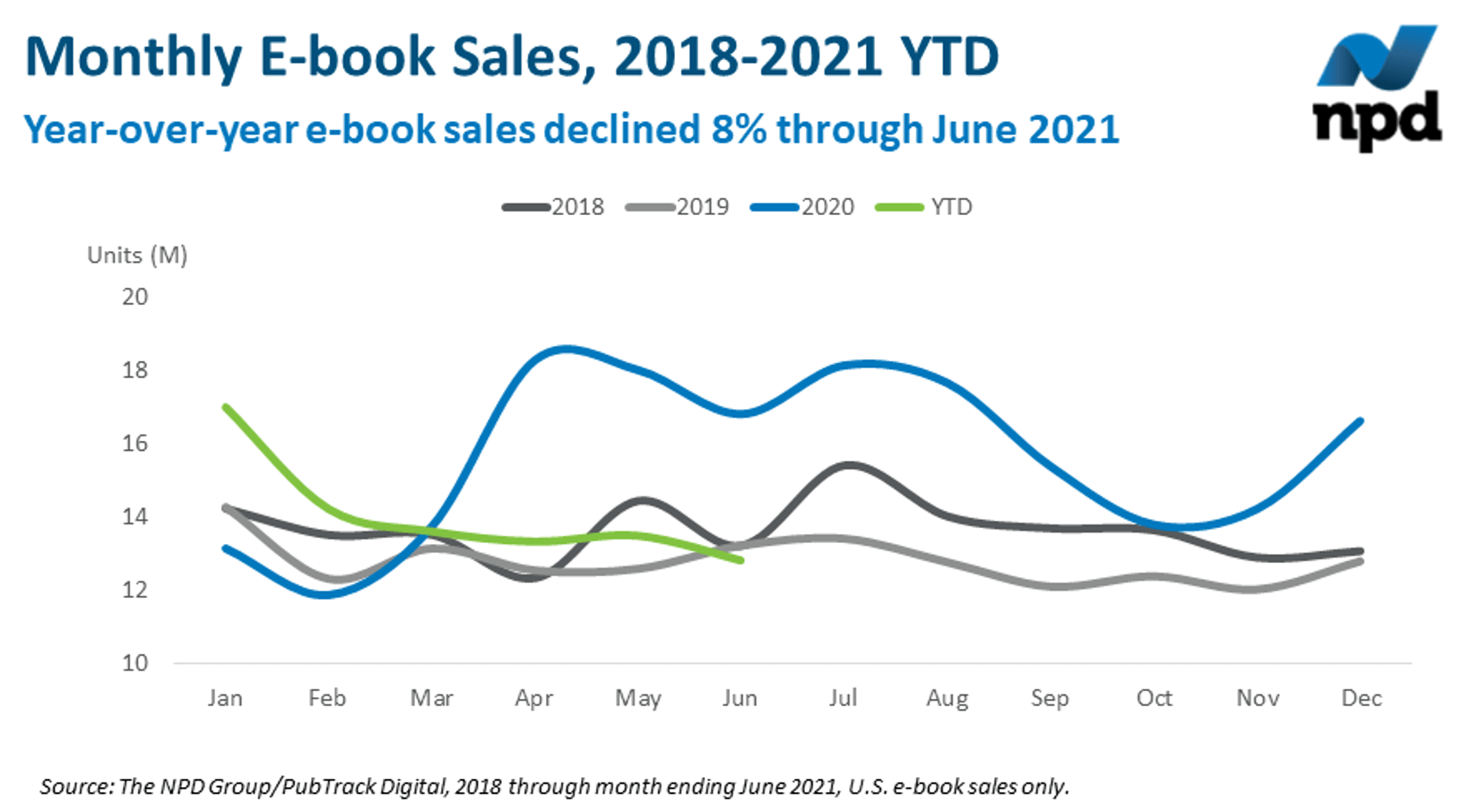
The Benefits of Print Books
A print book is a joy to behold!
The smell of freshly printed pages, the smooth, silky feel of paper beneath your fingertips, the crinkle, and crackle of a story flowing by.
Print offers a unique reading experience.
Digital e-readers don’t engage the senses the way a physical book does. Reading a printed book is a tactile experience.
You feel it, you smell it, and you remember it.
This is one reason physical books are the more popular format for readers. Printed books touch readers on a more primal emotional level.
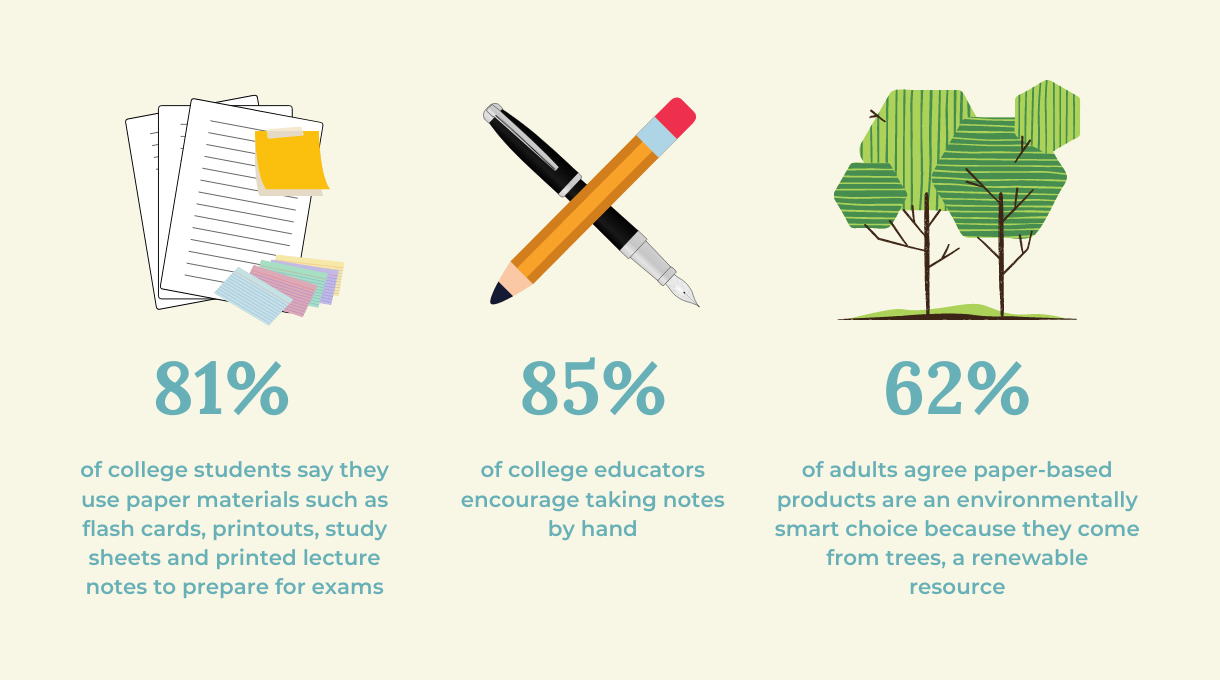
Physical Books vs eBooks Statistics Showing Why Traditional Books Are Better
- 66% of readers believe printed books offer a more unique and fulfilling reading experience than e-books.
- A majority of college students say they retain information longer when it is read in a printed format.
- Traditional books don’t cause the eye strain inherent to e-readers. Reading on an e-reader before bed disrupts sleep and impacts overall health
- Children learn better with paper books. Almost 90% of teachers and parents believe reading 15 pages on paper every day improves a child’s memory and language development.
- 64% of employees say they prefer paper agendas and memos to digital communication.
- E-readers take more carbon to produce than physical books.
- Discarded e-readers lead to toxic electronic waste. Old books can be recycled with other paper products.
Digital books bought online generally cost less. While a new hardcover can cost $30, the same book may only cost $15 on a Kindle e-reader. And that’s the top price for an eBook.
Most back titles are available for under five dollars. If you have limited income, e-readers and e-books are a better bargain when it comes to price.
In addition, reading a print book offers an uninterrupted “low tech” reading experience. E-readers and online reading in digital formats run the risk of pop-up ads, dying batteries, and power failures.
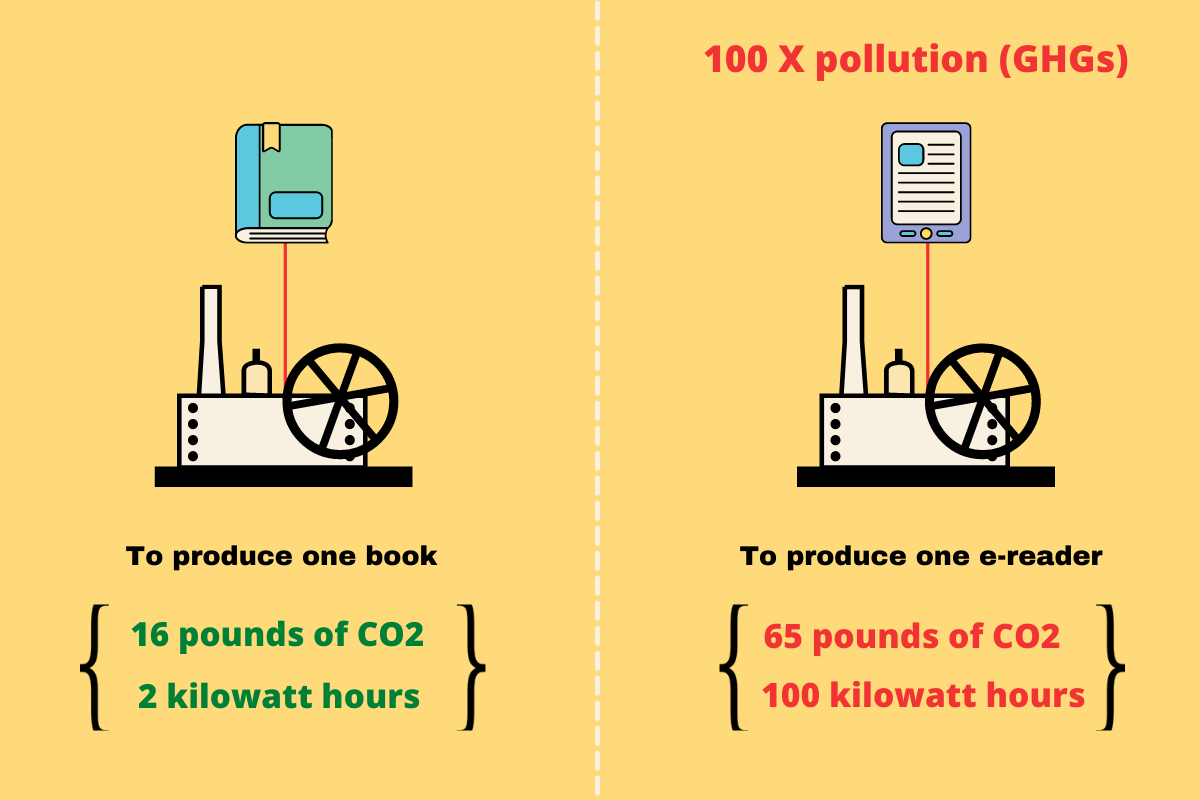
Despite its distribution limitations, print still reaches a broad demographic, especially among older readers.
For example, 41% of Americans over age 65 are not Internet users. The number of e-reader owners is even lower among this demographic.
The Future Of Printed Books
The statistics and surveys tell the story; despite the growing popularity of e-books, traditional publishing is here to stay.
The publishing industry uses market research to determine which book format a reader will prefer. U.S. libraries also contribute valuable data and figures on reader habits.
Another factor keeping traditional book publishing alive and well is the modern school system.
Textbook publishers have yet to embrace digital media. Heavy — and expensive — textbooks are still the norm for students. College students (and school boards) must buy the same textbooks year after year. Hey, the bulk of the information inside these textbooks hasn’t changed for centuries. Shouldn’t knowledge be free online somewhere?
Even though all the educational tools needed for academic success can be included on a lightweight laptop or tablet, print textbooks remain an essential part of classrooms.
This one of the main reasons readers prefer printed books over e-books — they were raised with print books all through school and they carry that love of physical books into adulthood.
The Future Of The eBook and E-Reader
A 2019 survey by Pew Research provides data and figures, which publishers use to determine which reading formats are most popular. While eBooks and e-readers were not the “print killers” some predicted they’d be, digital books continue to make slow gains in popularity.
The best-selling e-books are genre fiction — romance, crime, science-fiction, thrillers, and related genres.
The popularity of digital fiction in the United States is slated to grow over the next few years. As the popularity of e-books spreads, so too do the sales of e-book readers increase.
- Projected e-book sales in 2025 = $7.78 billion (up from $5.91 billion in 2019)
- Projected e-reader sales in 2025 = $98.95 million (up from $77.94 million in 2019)
What About Audiobooks?
We are in the midst of a “listening revolution” the likes of which the world hasn’t seen since the birth of radio.
The rise of podcasts and narrated stories means more people are listening to media than ever before.
However, these modern “books on tape” aren’t eating away at physical books or e-book sales as much as they’re bringing in new readers and giving seasoned readers a new way to enjoy the stories they love.
- One-in-five Americans listened to a book in 2021
- 100% of American publishers are creating audio
Diverse Book Consumption Formats Among U.S. Adults
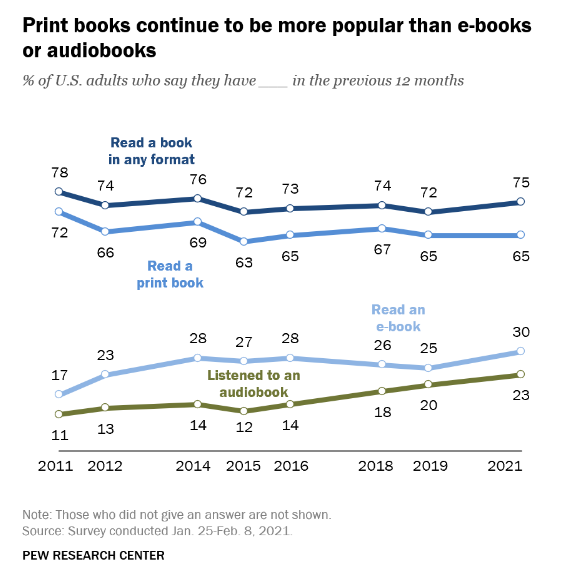
People Still Read Books... And Always Will
From a social media post to a blog article, people today read short-form writing on smartphones and tablets. But when they want to read in longer formats they turn to books, and, more often than not, they turn to “dead tree” editions printed with paper and ink.
Print books aren’t dying — they’re evolving, offering more accessible ways for people to enjoy them.
Technology has expanded our reading choices, allowing us to connect with books in different ways. In many ways — in terms of selection and availability — books are healthier than ever!
To get more insight into digital books vs. print books, we reached out to author Armand Rosamillia.
Rosamillia says his sales were pretty evenly split between print books, e-books, and audiobooks until the pandemic hit.
“Looking at my stats from the last 18 months, my sales are roughly 18% print, 27% audiobook, and 55% e-book,” Rosamillia reports. “Audio sales have nearly doubled since Covid, mostly affecting the print side.”
In addition to writing books, Rosamillia also runs The Little Free Library, a take-a-book / leave-a-book public bookshelf, which is a hit with younger readers.
Printed books are still preferred for nature journals, cookbooks, and children’s books. A recent Nielsen study found that parents and kids want to hold books and turn the pages together.
You can’t do that with an ebook.
The same goes for interactive books like coloring books, puzzles, and workbooks. You need traditional pages to get the most out of these books.
“Even though children are at ease with their tablets and technology (more so than I ever will be), they still gravitate toward the print books until they hit their teens, in my opinion,” Rosamillia says, “I have a Little Free Library on my property and the children go crazy whenever I put a new stack of picture books into it.”
And that’s good news for bibliophiles of any age!
Sources
NDP
Paper and Packaging Board’s Fourth Annual Back-to-School Report: Paper and Productive Learning
The New York Times
Olympic College
hms.harvard.edu/news/e-readers-foil-good-nights-sleep
pewresearch.org/short-reads/2022/01/06/three-in-ten-americans-now-read-e-books/
pewresearch.org/internet/2015/10/29/the-demographics-of-device-ownership/
pewresearch.org/fact-tank/2019/09/25/one-in-five-americans-now-listen-to-audiobooks/
pewresearch.org/internet/2014/04/03/older-adults-and-technology-use/
pewresearch.org/short-reads/2022/01/06/three-in-ten-americans-now-read-e-books/
publishers.org/news/aap-statshot-annual-report-book-publishing-revenues-up-slightly-to-25-93-billion-in-2019/
publishers.org/news/aap-january-2023-statshot-report-overall-publishing-industry-up-3-5-for-month-of-january/
thestar.com/business/opinion/2020/01/27/print-still-rules-when-it-comes-to-books-in-ontario.html
voxburner.com/blog-source/2015/5/18/16-24-prefer-books-as-physical-products
newzoo.com/wp-content/uploads/2011/06/PRESSRELEASE_2012_Kindle_Newzoo_15042012_V4.pdf
publishingperspectives.com/2022/11/aap-six-charts-on-the-us-book-market-2017-to-2021/
statista.com/statistics/422595/print-book-sales-usa/
statista.com/outlook/dmo/digital-media/epublishing/ebooks/worldwide
statista.com/outlook/amo/media/books/physical-books/worldwide
static1.squarespace.com/static/550334cbe4b0e08b6885e88f/t/6451113bd9fd6d74b9309140/1683034429461/CBC_2022_PDF.pdf
 Calculating arrival date
Calculating arrival date









